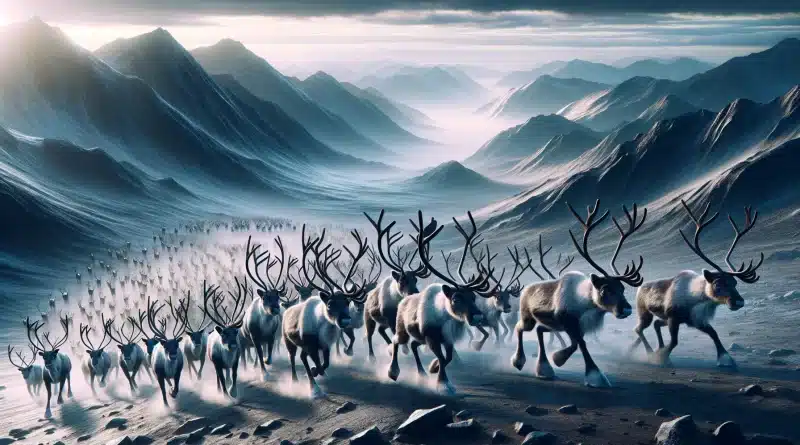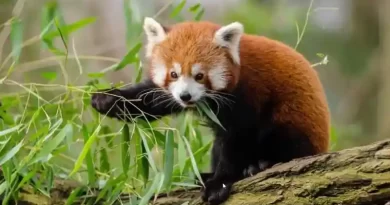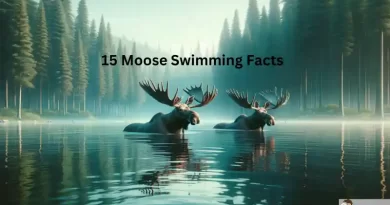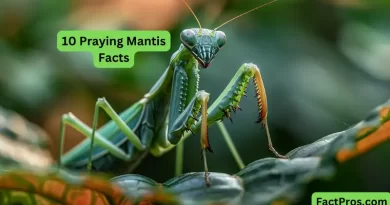25 Amazing Reindeer Facts: Unveiling the Arctic’s Majestic Wanderers
Reindeer have been capturing human imagination for centuries. In many cultures, they’re not just animals; they’re powerful symbols in folklore and myth. From the Sami people of Northern Europe who rely on them for survival, to the famous tales of Santa’s sleigh-pullers, reindeer have a special place in our hearts and histories. Let’s dive into the fascinating world of reindeer and discover what makes them so extraordinary!
Fascinating Reindeer Facts: The Basics
What’s in a Name?
When it comes to these Arctic roamers, names can be a bit of a mix-up. In most of Europe, they’re known as “reindeer”, a name that dates back to Old Norse words. But cross the Atlantic to North America, and suddenly they’re called “caribou”! It’s not just a quirk of language – it’s a reflection of how widespread and adaptable these animals are. Whether it’s the domesticated reindeer of Europe or the wild caribou of North America, these creatures are a testament to the diverse landscapes they inhabit.
Antler Anatomy
Now, let’s talk about the crowning glory of reindeer – their antlers. Unique in the deer family, both male and female reindeer grow antlers. That’s right, the ladies too! These aren’t just for show; they’re vital tools for survival. Males use them to battle for dominance during mating season, while females use them to protect food sources in the snow. What’s even more fascinating is how they grow these impressive headpieces. Every year, they shed their old antlers to grow new ones, a process that’s as remarkable as it is crucial to their survival in the wild.
Reindeer Physical Traits and Abilities
Moving on from the stunning antlers and diverse names, let’s delve into the physical prowess of these Arctic wonders. Reindeer are not just about looks; their bodies are marvels of nature, perfectly tuned to their challenging environment.
Size and Appearance
First off, let’s size them up! Reindeer vary in size, but typically, they’re about as big as a large dog, with some of the larger males reaching the size of a small horse. They’re wrapped in a cozy coat of fur that’s more than just a fashion statement. This fur is thick and dense, a crucial shield against the biting Arctic cold. And it’s not just ordinary fur; each strand is hollow, trapping air to provide remarkable insulation. Talk about a natural winter coat!
Nutrition from Antlers
Remember those amazing antlers we talked about? They’re not just for show or combat. Once shed, these antlers play a crucial role in the Arctic ecosystem. They become a source of calcium and other nutrients for other animals. It’s like a seasonal gift from the reindeer to their fellow Arctic dwellers, ensuring that even in the harshest conditions, life finds a way to sustain itself.
Social Animals
Reindeer aren’t lone wolves – they’re incredibly social creatures. They travel in large herds, sometimes numbering in the thousands, which is pretty mind-blowing! This isn’t just for company; it’s a smart survival strategy. In a herd, they can better protect themselves from predators, find food more efficiently, and navigate their way through their snowy world.
Built for the Cold
Speaking of snowy worlds, reindeer are the ultimate cold-weather champions. Aside from their insulated fur, they have other cool (pun intended!) adaptations. Their noses warm the air before it reaches their lungs, and their hooves change with the seasons – they shrink and tighten in the winter for a better grip on ice and expand in the summer for softer ground. Nature’s all-terrain vehicles!
Diet and Feeding
What’s on the menu for a reindeer? In the winter, it’s all about survival eating. They primarily feed on lichen, a type of plant that’s abundant in the Arctic, even scraping it from under the snow. In the warmer months, they switch to a more varied diet of grasses, leaves, and herbs. This shift in diet shows just how adaptable these creatures are to their ever-changing environment.
Unusual Characteristics of Reindeer
Just when you thought reindeer couldn’t get any more fascinating, hold onto your hats! We’re about to explore some of their most unusual and intriguing characteristics. These features truly set them apart in the animal kingdom and show just how special they are.
Unique Hooves
Let’s start from the ground up – their hooves. Reindeer hooves are like the Swiss Army knives of the animal world. In the winter, their hooves harden to dig through the snow to find food. Come summer, these hooves soften to give them better traction on the soft, wet tundra. It’s like having snow boots and all-terrain sneakers all in one!
Reindeer as Swimmers
Think reindeer are just about the snow? Think again! These animals are also surprisingly good swimmers. Thanks to their hollow fur, which helps with buoyancy, and their large, flat hooves that act like natural paddles, reindeer can swim easily across large rivers and even icy waters. So, if you thought they only roamed the frozen land, they’re just as comfortable taking a dip!
Ultraviolet Vision
Now, for one of the coolest things about reindeer: their vision. Of all the Reindeer facts, it is cool that they can see ultraviolet light, which is invisible to humans. Why is this important, you ask? In the Arctic, where everything is covered in snow and ice for most of the year, this ability allows them to see things that are otherwise invisible in the glaring white landscape, like food and predators. It’s like having built-in night-vision goggles!
Reindeer and Human Societies
Now, let’s turn our attention to the remarkable relationship between reindeer and humans. These animals have been intertwined with human cultures for thousands of years, playing a crucial role in the survival and traditions of many communities.
The Deer of Utility
Reindeer are more than just majestic creatures roaming the wild; they are a vital resource for many people, especially in the Arctic regions. Indigenous peoples, like the Sami of Scandinavia and the Nenets of Russia, have depended on reindeer for centuries. They use them for transport, pulling sleds across the snowy terrain, and as a source of food, clothing, and even tools. The bond between these communities and their reindeer is not just practical; it’s a deep cultural and spiritual connection.
Wool and Clothing
One of the most prized products from reindeer is their wool. It’s incredibly warm and insulating, making it perfect for clothing in frigid climates. The indigenous peoples of the Arctic have mastered the art of turning this wool into garments that can withstand extreme cold, from thick coats to cozy socks. This traditional knowledge of using natural resources is a testament to human ingenuity and adaptability.
Nutritious Milk
Did you know that reindeer milk is a thing? It’s not as common as cow’s milk, but it’s a staple in some Arctic communities. Reindeer milk is rich in fat and protein, making it highly nutritious. In areas where other dairy sources are scarce, this milk becomes an essential part of the diet.
Mating Rituals
The mating rituals of reindeer are a fascinating spectacle. During the autumn rut, males compete for the attention of females by displaying their magnificent antlers and engaging in vocal displays and physical contests. It’s a time of intense competition, where the strongest and most impressive males get the chance to pass on their genes.
Reindeer Reproduction
The reproductive cycle of reindeer is finely tuned to the harsh Arctic environment. After a gestation period of about 230 days, females usually give birth to a single calf in the spring. This timing ensures that the young are born when the weather is milder, and food is more abundant, giving them a better chance of survival.
Reindeer Facts: Culture and Legend
Reindeer aren’t just physical beings; they gallop through the realms of culture and legend too. Their presence in folklore and traditions across the world is as rich and varied as the landscapes they inhabit.
Santa’s Sleigh Team
No discussion of reindeer in culture would be complete without mentioning their most famous role: pulling Santa Claus’s sleigh! This iconic image is etched into the Christmas traditions of many countries. Each year, children around the globe eagerly await the arrival of Santa and his flying reindeer, with Rudolph and his glowing red nose leading the way. It’s a magical tale that adds to the mystique and charm of these incredible creatures.
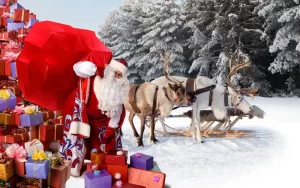
Population and Distribution
But let’s get back to reality for a moment. Reindeer are found in various parts of the world, predominantly in the Arctic and subarctic regions. The populations of reindeer vary greatly, from the domesticated herds of northern Europe to the wild caribou of North America. Understanding their distribution and population dynamics is crucial for their conservation and the preservation of the cultural traditions that rely on them.
As we near the end of our reindeer journey, we’ll look into the challenges these magnificent creatures face and why their conservation is vital.
Threats to Reindeer Populations
As we delve deeper into the world of reindeer, it’s essential to recognize that these majestic creatures face significant challenges. Understanding these threats is crucial for their protection and the continuation of the rich cultural heritage associated with them.
Challenges Faced
Reindeer populations are not immune to the challenges of the modern world. They face threats from various fronts, including poaching and unsustainable hunting practices. In some regions, these activities are regulated by hunting laws, but enforcement can be a challenge. Additionally, natural predators like wolves and bears also pose a threat, especially to younger, more vulnerable members of the herd.
Impact of Development
One of the most pressing threats to reindeer is the loss of their natural habitat. As industrial development expands into the Arctic and subarctic regions, the traditional roaming grounds of reindeer are being disrupted. This encroachment affects their migration patterns, access to food sources, and overall survival. Climate change compounds these challenges, altering the delicate balance of their ecosystems and making it harder for reindeer to thrive.
Exploring the Enchanting World of Reindeer: 25 Captivating Reindeer Facts
Introduction: Have you ever wondered about the majestic creatures trotting through the snowy landscapes of the Arctic? Reindeer, known for their extraordinary abilities and cultural significance, are far more than just holiday symbols. They’re fascinating animals with unique characteristics that allow them to thrive in some of the harshest environments on Earth. From their incredible antlers to their surprising swimming skills, reindeer are full of surprises. In this section, we’ll uncover 25 amazing facts about these enchanting creatures that roam the northern wilderness. So, buckle up for an exciting journey into the world of reindeer!
Table: 25 Reindeer Facts
| No. | Category | Interesting Facts |
|---|---|---|
| 1 | Unique Antlers | Both male and female reindeer grow antlers. |
| 2 | Names Across Continents | Known as ‘reindeer’ in Europe, and ‘caribou’ in North America. |
| 3 | Adaptation to Cold | Perfectly adapted for life in cold climates. |
| 4 | Fur Insulation | They have two layers of fur for insulation against the cold. |
| 5 | Specialized Hooves | Their hooves adapt to seasonal changes, providing grip on ice and soft ground. |
| 6 | Arctic Inhabitants | Native to Arctic and subarctic regions. |
| 7 | Swimming Skills | Strong swimmers, able to cross large rivers and lakes. |
| 8 | Ultraviolet Vision | Can see ultraviolet light, aiding Arctic navigation. |
| 9 | Cultural Significance | Have deep cultural significance for indigenous Arctic peoples. |
| 10 | Herding Practices | Some cultures herd reindeer for transport, milk, and food. |
| 11 | Migratory Patterns | Undertake long migrations, up to 3,000 miles annually. |
| 12 | Diverse Diet | Diet includes grasses, herbs, ferns, mosses, and lichen. |
| 13 | Antler Shedding | Male reindeer shed their antlers in winter, females in summer. |
| 14 | Sensitivity to Climate Change | Climate change significantly affects their habitat and food sources. |
| 15 | Distinct Subspecies | Several subspecies, each adapted to different environments. |
| 16 | Long Lifespan | Can live up to 15 years in the wild. |
| 17 | Famous in Folklore | Popularized by the Christmas song and story. |
| 18 | Natural Predators | Natural predators include wolves, bears, and golden eagles. |
| 19 | Social Animals | Live in large herds, providing safety in numbers. |
| 20 | Impressive Speed | Can run up to 60 miles per hour. |
| 21 | Variation in Size | Size varies significantly based on the subspecies. |
| 22 | Antler Uses | Shed antlers used by other animals for nutrients. |
| 23 | Vocal Communication | Use various sounds to communicate within the herd. |
| 24 | Nutritious Milk | Milk is rich in fat and protein, key for some cultures. |
| 25 | Conservation Status | Many populations are declining due to habitat loss and other factors. |
Wrap Up
As we finish our reindeer exploration, it’s clear that these animals are not just symbols of holiday cheer or mere subjects of folklore. They are vital components of the ecosystems they inhabit and play a significant role in the cultures of many indigenous peoples. The challenges they face remind us of the delicate balance of nature and the impact of human activities on wildlife. By learning about and appreciating these magnificent creatures, we take a step toward their conservation and the preservation of the natural world they represent. Let’s all play a part in ensuring that reindeer continue to roam the Arctic landscapes for generations to come. 🦌🌍❤️
Reindeer Facts FAQ
Yes, both male and female reindeer grow antlers, which is unique among deer species. Males use them for dominance battles, while females use them for foraging in the snow.
Reindeer have several adaptations to cold climates, including thick, insulating fur, noses that warm incoming cold air, and hooves that change seasonally for better traction.
Reindeer hold significant cultural value, particularly in indigenous Arctic communities like the Sami and Nenets, who rely on them for survival. Globally, they’re known as Santa’s sleigh pullers.
Reindeer hooves adapt seasonally – they harden in winter to dig through snow and soften in summer for better grip on soft, wet ground, making them highly versatile for varying terrains.
The main threats to reindeer include habitat loss due to industrial development, climate change, poaching, and natural predators like wolves and bears.

